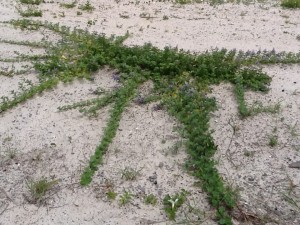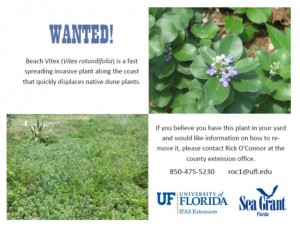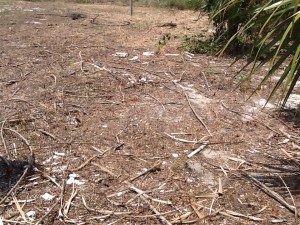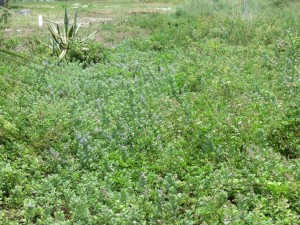
Beach vitex expands its woody rhizomes aggressively; it can actually grow over sidewalks and driveways.
It’s actually a pretty plant, this Beach Vitex (Vitex rotundifolia), and it is very good at stabilizing eroding dunes. In the 1990’s, the state of South Carolina planted this shrub to help restore dunes lost during hurricanes. It was selected because of salt tolerance, production of woody rhizomes (runners) that extend over 60 feet to trap sand, and the beautiful purple flowers that attract beneficial insects; it seemed perfect! However, folks along the Atlantic coast had no idea how invasive it would become a few years later. Residents discovered that it chokes out many of the native species such as sea rocket and sea oats producing an area of only this plant.
It is now causing problems for sea turtles. As you can see in some of these photos, the plant grows over the fore-dune, blocking access for nesting. Beach Vitex grows so aggressively that during the 60 day incubation time many turtle nests are overgrown, entrapping the hatchlings. Some have been found dead, entangled within the rhizome mats. The Beach Vitex “invasion” has become so bad that South Carolina developed a Vitex Task Force to deal with the problem.
Is this a problem for Florida?
According to the records the Early Detection and Distribution Mapping System EDDmaps.com, Beach Vitex is distributed northward to the Chesapeake Bay area and south to Jacksonville. It is found in coastal Alabama and there is one record of the plant in Escambia County.
With so few records in Florida it is not currently listed as an invasive species in our state and there is no program set up to control it. However the Sea Grant Extension Agent in Escambia County, Rick O’Connor, was alerted in 2013 that vitex was in Gulf Breeze, Florida (Santa Rosa County) and possibly on Santa Rosa Island (Escambia County).

Please circulate to area residents to provide visual identification of Beach Vitex. Contact your Extension Office for control options and help reduce it’s impact on native species.
A “Wanted Poster” was developed by O’Connor to post in the coastal communities of Escambia and Santa Rosa counties to see if the plant was more common than the records indicated. At this time, six properties on Santa Rosa Island have confirmed records of Vitex and two more will be surveyed soon. The wanted poster program was published in the local newspaper which reached the east coast of Florida. Reports from that coast indicate that it has extended south into Volusia County. Okaloosa/Walton Sea Grant Agent Brooke Saari is posting the wanted poster in those counties to see if the plant has reached their coasts.

The owner of this yard mowed the vitex. However the woody rhizomes are still present. They will need to either dig this up or use multiple chemical applications to completely remove.
Anyone along the coast of the Florida Panhandle who feels they may have this plant can contact either Rick O’Connor (850-475-5230; roc1@ufl.edu) or Brooke Saari (850-689-5850; bsaari@ufl.edu) and we can confirm identification. The plant is not currently listed as invasive in our state and removal is not required. However, based on the experience in the Carolina’s and other invasive species, if you wish to eradicate this plant doing so early is important. It is much less labor intensive and less costly when there are few plants. If you do choose to remove it please contact your local Extension office first. We can provide methods of successful removal. We would also like to photograph and log the record on EDDmaps.
Editor’s note: Rick provided all the photos in this article.
- Our Environment: Part 11 – We Need Water - July 7, 2025
- Our Environment: Part 10 – Improving Agriculture - June 20, 2025
- Marine Creatures of the Northern Gulf – Snails and Slugs - June 20, 2025

